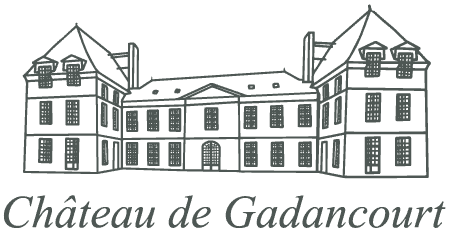Life at Gadancourt in the 19th century
The 19th century is considered to be the golden age of the chateaux. This was the case at Gadancourt where the domain was developed thanks to the attentions of the Roger des Gadancourts and their descendants, the Aubourg de Bourys. Unlike their 18th century ancestors, who passed part of their time in Paris and part in the Vexin, they chose to live in the country throughout the year.
Life at Gadancourt in the 19th century
The 19th century is considered to be the golden age of the chateaux. This was the case at Gadancourt where the domain was developed thanks to the attentions of the Roger des Gadancourts and their descendants, the Aubourg de Bourys. Unlike their 18th century ancestors, who passed part of their time in Paris and part in the Vexin, they chose to live in the country throughout the year.

« Monsieur de Gadancourt et de Gouzangrez »
Following the death of Pierre-Victor Roger de Gadancourt et de Villers on 27 December 1805, his third son, Pierre-Frédéric Roger de Gadancourt, who had been known in his youth as Monsieur de Gouzangrez, inherited Gadancourt, as well as the Chateau de Bray in Bray-et-Lu where he was already living.
His older brother, Alexandre-François, took charge of Villers-en-Arthies, the name of which he already bore. He was the source of the Roger, counts of Villers branch of the family which still exists today.
Athanase-Victor Roger d’Arquinvilliers, the second son, inherited the chateau and estate of the same name in the Beauvais area, which his grandfather bought in 1760 He was twice mayor of Pontoise under the Empire and the Restoration, councillor general in the department of Seine-et-Oise, and died in the Chateau of Saint-Martin, where he lived.
Hardly had he taken up residence at Gadancourt than Pierre-Frédéric Roger de Gadancourt had the misfortune to lose his wife, Angélique Brochant de Tournelles, who was only 26 years old. She left behind her two young children, Frédérique-Victor and Clara. Pierre-Frédérique died in his turn on 25 April 1826 at the age of 64.
Alliance with the Boury family
His son, Frédéric-Victor, who succeeded him, was mayor of Gadancourt from 1820 to 1848. He married Charlotte-Thaïs de Boury, the daughter of Guillaume Aubourg, count of Boury, who came from the old family which built the Chateau de Boury-en-Vexin. In 1847, the couple’s only child, Mathilde, married the Charlotte-Thaïs’s younger brother, Baron Octave de Boury, who was thus her uncle, although he was only three years older than her.
When her husband died in 1848, Thaïs de Boury became a nun in the Convent of the Visitation in Paris. She died there in 1858 Her son-in-law and daughter offered the Maison des Soeurs in Avernes to the village in her memory on condition that there were maintained “eternally in the village two or three sisters for the education of young girls and care of the sick”. The Sisters of the Visitation moved in, followed by the Daughters of Charity, who were themselves succeeded in the 1980s by Spanish nuns from the Handmaids of the Sacred Heart of Jesus.
Octave de Boury made his own contribution to the embellishment of the chateau. It was he who ordered the construction of the little tower on the northern pavilion, which was built in 1866 to replace a former toilet, as well as the little bell tower which gives the big medieval commons building its characteristic appearance.
When war broke out in 1870, Guillaume de Boury, Octave’s oldest son, who was then 20, was mobilised and took part in the siege of Paris. He recalled a terrible experience in which he was obliged to “eat rat”. Following the debacle, Octave, his father, who was the mayor of Gadancourt, was forced to accept the requisitions of the Prussians. In March 1871, Gadancourt was ordered to accommodate up to 550 Prussians, most of them in the chateau but some also in the village. “There, no one is master in his own home,” the baron wrote. “These people drive the inhabitants from their beds, the animals from their stalls, stables and sheepfolds, light the fire in the chateau bakery, mistreat people…”. It was only at the beginning of May that the situation returned to normal.
In 1884, Baron Guillaume de Boury succeeded his father as mayor of Gadancourt. Until his death in 1923, he devoted himself to the service of his fellow citizens, earning himself the local nickname of “Good Monsieur de Boury”. In 1881, he married Louise Perrot de Chazelles, who came from a noble family in Burgundy. On her mother’s side, Louise de Chazelles was the granddaughter of the historian and Académie Française member, Prosper de Barante, who was a prefect under Napoleon and French ambassador in Moscow under the July Monarchy.
All the family’s hopes now reposed on Joseph, their only son, who was born in 1890 and was preparing to take charge of the Gadancourt estate…





